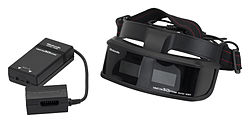Famicom 3D System
| Manufacturer | Nintendo |
|---|---|
| Type | Video game accessory |
| Generation | Third generation |
| Lifespan |
|
| Connectivity | Famicom expansion port 2 3.5 mm jacks (glasses) |
The Famicom 3D System[1] is a Japan-exclusive accessory for the Nintendo Family Computer released[2] in 1987.
Overview
[edit]The 3D System consists of a pair of active shutter glasses and an adapter to connect them to the Famicom's third player expansion port. The glasses are connected to the adapter via dual 3.5 mm jacks. This allowed compatible games to display a stereoscopic image similar to that of the Sega Master System's SegaScope 3-D Glasses. Games would play in conventional 2D until a "3D mode" was activated by use of the select button.[3]
Twin Famicom 3D System
[edit]Sharp Corporation released their own branded version of the 3D System called the Twin Famicom 3D System.[4] Though marketed towards users of Sharp's Twin Famicom, it was equivalent to the 3D System with only cosmetic differences.
Reception and legacy
[edit]The 3D System was a commercial failure and, as a result, was never released outside Japan.[2] Criticisms included the clunkiness of the glasses and the limited selection of compatible titles. Eight years later, in 1995, Nintendo again ventured into stereoscopic gaming with the commercially unsuccessful Virtual Boy. In the following years, Nintendo experimented in stereoscopic 3D with both the GameCube and Game Boy Advance SP systems, but these features were not released commercially due to cost and technical limitations.[5] In 2011, Nintendo released the 3DS handheld capable of displaying stereoscopic 3D images without the need for special glasses. The 3DS has enjoyed a largely positive reception. In 2019 Nintendo released a Labo VR Kit.
List of compatible games
[edit]- Attack Animal Gakuen by Pony Canyon
- Cosmic Epsilon by Asmik
- Falsion[6] by Konami
- Famicom Grand Prix II: 3D Hot Rally[5] by Nintendo
- Highway Star (Rad Racer outside Japan)[7] by Square
- JJ: Tobidase Daisakusen Part II by Square
- Fuuun Shourin Ken - Ankoku no Maou by Jaleco
See also
[edit]References
[edit]- ^ Packaging material refers to it as the Family Computer 3D System (ファミリー コンピュータ スリーディー システム). The product itself only has "FAMICOM 3D SYSTEM".
- ^ a b Plunkett, Luke. Nintendo's First 3D Technology Shot A Spaceship At Mario's Face. Kotaku. 30 April 2010.
- ^ Famicom 3D System at Famicom World
- ^ ファミコンの周辺機器が大集合 (in Japanese). Archived from the original on 2 February 2015. Retrieved 9 July 2014.
- ^ a b Iwata, Satoru. And That's How the Nintendo 3DS Was Made - Satoru Iwata Talks About Past Projects. Iwata Asks. 2011.
- ^ Sachdev, Ishaan. The Remarkable History Of The 3DS. Siliconera. 19 June 2010.
- ^ Porter, Rick. ed. Square Enix’s Rad Racer could be the 3DS’s next 3D Classic. GamesTM. 2 June 2011.
External links
[edit]| Accessories |
| ||||
|---|---|---|---|---|---|
| Hardware |
| ||||
| Software | |||||
| Variations and hardware clones | |||||
| Related | |||||
Preceded by Color TV-Game • Succeeded by Super Nintendo Entertainment System | |||||
| Consoles |
| ||||||||||||
|---|---|---|---|---|---|---|---|---|---|---|---|---|---|
| Peripherals |
| ||||||||||||
| Arcade | |||||||||||||
| Integrated circuits | |||||||||||||
| Media | |||||||||||||
Extended reality (XR) | |||||||||||
|---|---|---|---|---|---|---|---|---|---|---|---|
| |||||||||||
| Concepts | |||||||||||
| Technologies |
| ||||||||||
| Peripherals | |||||||||||
| Devices |
| ||||||||||
| Software |
| ||||||||||
Text is available under the CC BY-SA 4.0 license; additional terms may apply.
Images, videos and audio are available under their respective licenses.

